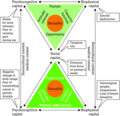Chapter 27: Living with and beyond cancer
Skip chapter table of contents and go to main content

Related theory
Sexuality is one of the four primary domains of quality of life (mental, physical, social, sexual) in which sexual quality of life generally refers to body image, sexual desire and sexual functioning (Buchholz et al. [33]). Traditional models define sexual functioning mechanistically in terms of the human sexual response cycle: arousal, plateau, climax (orgasm), and resolution (Masters and Johnson [169]). Newer sexual functioning models incorporate psychological parameters defining sexual dysfunction as an interference in the ability to engage in sexual activity or disruption of the full sexual response cycle (Boquiren et al. [21]).
The interactive biopsychosocial model (IBM) (Lindau et al. [145]) is a theoretical framework of sexuality in the context of ageing and illness (Figure 27.4). The three main characteristics of an individual's sexual expression within the framework include sexual opportunity (defined as the social possibility for partnership), sexual capacity (including the type and frequency of physical behaviours both partnered and unpartnered) and sexual function (relating to the human sexual response cycle encompassing desire, arousal and orgasm) (Masters and Johnson [169]).

Figure 27.4 Interactive biopsychosocial model of sexuality in the context of cancer, with examples in each domain that influence sexuality. Source: Lindau et al. ([145]). Reproduced with permission of Johns Hopkins University Press and Elsevier.
The bi‐directional relationship between health and sexuality in this framework is theorized across the life span.
Bober and Varela's integrative biopsychosocial model for intervention proposes that sexuality is composed of psychological, relational, biological and cultural factors and therefore an understanding and consideration of all these elements is required when appraising a cancer survivor's experience. Planned interventions must reach beyond the traditional mechanistic approach of sexuality to also consider available resources that can assist mental health, relationship and cultural concerns (Varela et al. [279]).





